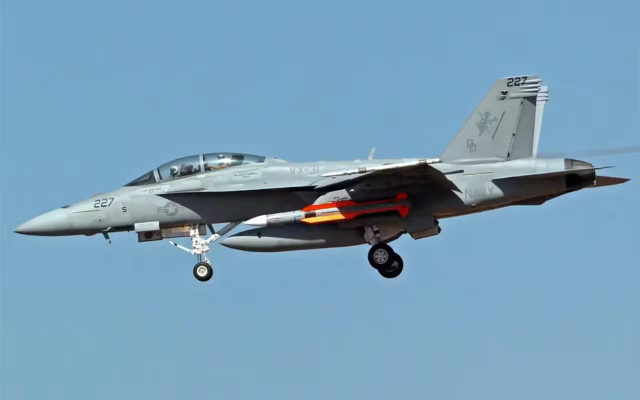
RIMPAC: US Navy Showcases “Longest-Range” Missile for Super Hornets, Set to Deter Adversaries
Fiona Nanna, ForeMedia News
4 minutes read. Updated 9:00AM GMT Mon, 8 July, 2024
The US Navy recently showcased two AIM-174B missiles – the air-launched version of the SM-6 missile – mounted on an F/A-18E Super Hornet from the VFA-192 “Golden Dragons.” These developments took place on the USS Carl Vinson aircraft carrier at Joint Base Pearl Harbor-Hickam, Hawaii, as part of the ongoing Rim of the Pacific (RIMPAC) drills.
RIMPAC, the world’s largest international maritime exercise, hosted by the United States, draws the attention of global military powers, including China and Russia. The new missiles, marked with the AIM-174B designation, are noteworthy for their exceptional long-range air-to-air capabilities. However, they also possess the unique ability to function as quasi-ballistic missiles, capable of targeting high-priority ground installations such as air defense sites and warships.
Photographic Evidence and Military Significance
The latest photographs, credited to aeros808 on Instagram, captured the Super Hornet taxiing with the AIM-174B missiles prominently displayed. These missiles, labeled as inert and devoid of warheads, marked a significant milestone in the US Navy’s missile development program. This follows earlier sightings in June 2024, where an F/A-18 Super Hornet was observed carrying what appeared to be an air-launched variant of the SM-6.
Experts have closely scrutinized these sightings, given the rarity of seeing an SM-6 missile on a Super Hornet. The latest appearance at RIMPAC suggests the US Navy is testing new tactics and capabilities, possibly including live-fire exercises.
Tactical Evolution and Strategic Implications
The AIM-174B’s potential extends beyond traditional air-to-air engagements. According to the US Navy, as reported by Naval News, the SM-6 Air Launched Configuration (ALC) is already operationally deployed. The missile’s integration into the Super Hornet significantly enhances the aircraft’s strike capabilities, allowing it to engage targets over great distances and at near hypersonic speeds.
The concept of arming Super Hornets with SM-6 missiles has been under consideration for years. In 2018, discussions emerged about integrating the SM-6 Dual I SAM, transforming it into a long-range air-to-air missile. The latest developments indicate that this idea is now a reality, with the AIM-174B providing a significant boost to the US Navy’s combat effectiveness.
Enhancing US Naval Capabilities
Raytheon, the manufacturer, describes the SM-6 as a multi-role missile capable of anti-air warfare, anti-surface warfare, and ballistic missile defense. This versatility makes it a formidable addition to the US Navy’s arsenal. The integration of air-launched SM-6 missiles with Super Hornets enhances the Navy’s ability to counter a wide range of threats, including enemy aircraft and ballistic missiles, at distances previously unattainable.
This capability is crucial in the context of potential conflicts with adversaries like China, which continues to expand its missile arsenal. The AIM-174B provides the US Navy with a powerful tool to disrupt and neutralize enemy defenses, ensuring superiority in contested environments.
Future Prospects and Strategic Defense
The induction of the AIM-174B marks a significant advancement in the US Navy’s strategic defense capabilities. The missile’s ability to target high-priority ground and maritime threats positions it as a quasi-ballistic missile, a category of increasing importance in modern warfare. This development is particularly relevant given China’s rapid deployment of long-range missiles and sophisticated Anti Area/Access Denial (A2/AD) systems.
The AIM-174B’s integration with the Naval Integrated Fire Control-Counter Air (NIFC-CA) architecture, alongside platforms like the E-2D, F-35, and Aegis, extends the Navy’s engagement range and defensive reach. This multi-layered defense strategy enhances the protection of forward territories and critical assets.
The US Navy’s unveiling of the AIM-174B missile at RIMPAC underscores its commitment to maintaining technological and strategic superiority. As tensions in the Indo-Pacific region remain high, the ability to deploy advanced weapons systems like the AIM-174B provides a significant deterrent against potential adversaries. The continued evolution of the Super Hornet, coupled with cutting-edge munitions, ensures that the US Navy remains a formidable force capable of addressing diverse threats in an ever-changing global landscape.
For more insights into the latest military developments and strategic defense capabilities, visit Naval News.

